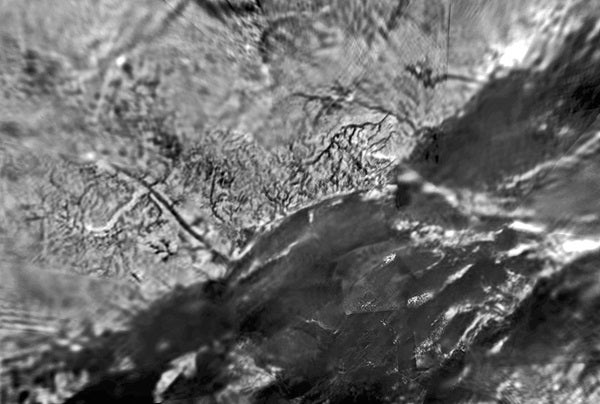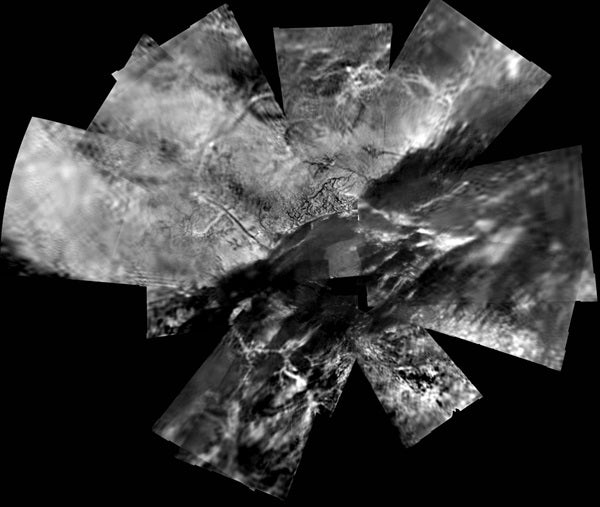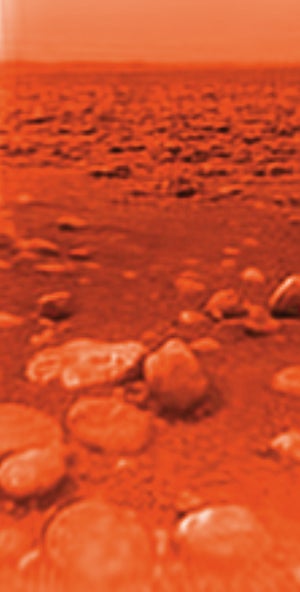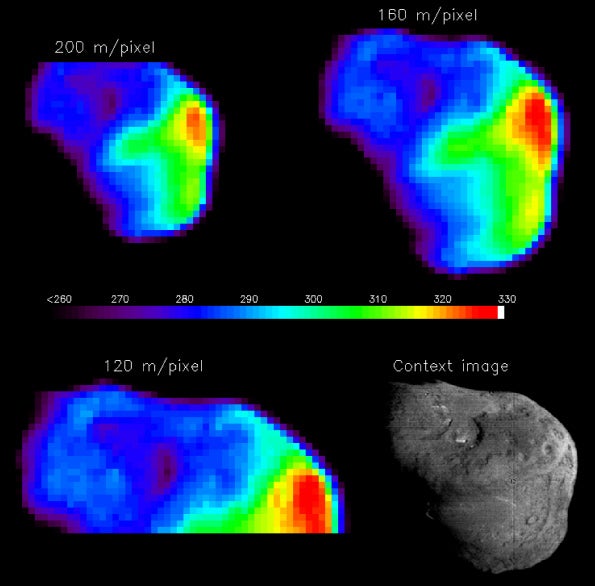On January 14, 2005, as the Huygens probe drifted through the atmosphere of Saturn’s moon Titan, unexpectedly strong winds buffeted the craft. It swung wildly under its parachute, and for most of its descent spun in a direction opposite the one scientists had intended. The Sun sensor, which was supposed to provide crucial positional information, kept locking up. To confuse matters further, Titan’s winds reversed direction near the surface, making it harder for mission scientists to know exactly where the spacecraft landed.
“You can’t even begin the analysis until you know where the instruments are pointing,” says Martin Tomasko, lead investigator for the Huygens Descent Imager-Spectral Radiometer (DISR). “In the lower 30 kilometers [18 miles], where we didn’t see the Sun any longer, we basically took data at random angles.”
Six months passed before the DISR team began studying Titan in earnest. Constructing panoramic mosaics requires knowing the probe’s spatial location (longitude, latitude, and altitude) and its attitude (roll, pitch, and yaw) for each triplet of images the DISR cameras acquired.
“The Huygens Atmospheric Structure Instrument pressure sensor provided altitudes, but none of the other variables was directly measured,” says Bashar Rizk, a DISR team member. “They were found through an iterative process.” The team created a first-pass panorama, which gave an improved view of the probe’s ground-track. “This led to an upgraded trajectory, which improved the panorama, and so on,” he adds.
Tomasko notes that Titan’s haze descends all the way to the ground — no clear layer exists near the surface. And the haze particles grow to sizes 3 to 4 times greater than scientists expected. “That changes the optical and other properties of the haze. We’re trying to work all that out now,” he says.
“I think entry-probe missions really are extra-ambitious,” Tomasko says. “When you’re making the first entry to a place you’ve never been before, you’ve got to worry about winds; you’ve got to worry about icing, and condensation, and being struck by lightning — there’s just a whole host of things you know nothing about.” Designers built Huygens to survive what amounts to their best guess of the environment the probe would encounter.
“You bless it, launch it, and wait 7 years for it to get there. And then you hope everything works perfectly and that there are no surprises,” Tomasko says. “When they work, it’s really gratifying.”
“Prior to our Deep Impact experiment, scientists had a lot of questions and untested ideas about the structure and composition of the nucleus, or solid body of a comet, but we had almost no real knowledge,” says the University of Maryland’s Michael A’Hearn, the project’s principal investigator. “Our analysis … is revealing a great deal, much of it rather surprising.”
Deep Impact’s July 4, 2005, comet crash promised “your first look inside a comet,” but it didn’t quite deliver as advertised. The impact probe hit the comet with the energy equivalent of 4.5 tons of TNT — enough, scientists hoped, to blow a 330-foot (100 meter) hole into Comet Tempel 1’s surface. An impenetrable screen of dust thrown up by the explosion prevented the Deep Impact mothership from seeing the impactor’s crater.
Astronomers watched events unfold using observatories around and above the world. In addition to expected ingredients like water, olivine, and silicate dust, observations with the Spitzer Space Telescope revealed chemicals never seen before in comets, such as iron-bearing compounds and aromatic hydrocarbons, found in barbecue pits and automobile exhaust on Earth. But what really surprised astronomers was the presence of substances like clay and carbonates (a material found in seashells), compounds that need liquid water to form.
“How did clay and carbonates form in frozen comets?” asks Carey Lisse of Johns Hopkins University’s Applied Physics Laboratory, team leader for the Spitzer observations. “We don’t know, but their presence may imply that the primordial solar system was thoroughly mixed together, allowing material formed near the Sun where water is liquid, and frozen material from out by Uranus and Neptune, to be included in the same body.”
A team led by Michael Mumma of NASA’s Goddard Space Flight Center used the Keck Telescope atop Hawaii’s Mauna Kea to view the comet’s spectrum before, during, and after impact. This enabled the astronomers to distinguish surface gas from the dusty plume. Repeated solar heating boils materials with low freezing points, like carbon monoxide, out of a comet’s surface. Over time, this process makes the comet’s crust different from its interior — this means it’s impossible to discover a comet’s true composition by looking at gas evaporating from the surface. One of Deep Impact’s objectives was to glimpse ice below the surface that had been less altered by the Sun.
“The amount of ethane in the cloud around the comet was significantly higher after impact than before,” Mumma says. By measuring the relative amounts of comet chemicals, astronomers can estimate where in the solar system it formed. A comet born farther from the Sun will have greater amounts of ices with low freezing points, like ethane, than one that formed closer to the Sun. If Mumma’s results reflect the fraction of ethane Tempel 1 was born with, the comet may have formed in the neighborhood of present-day Uranus and Neptune.
But now, 5 months after the mission’s main event, scientists “can stop guessing at what’s inside comets,” says A’Hearn. “This information is invaluable for piecing together how our own planets — as well as other distant worlds — may have formed.”
“The Deep Impact experiment worked,” Lisse says. “We are assembling a list of comet ingredients that will be used by other scientists for years to come.”














